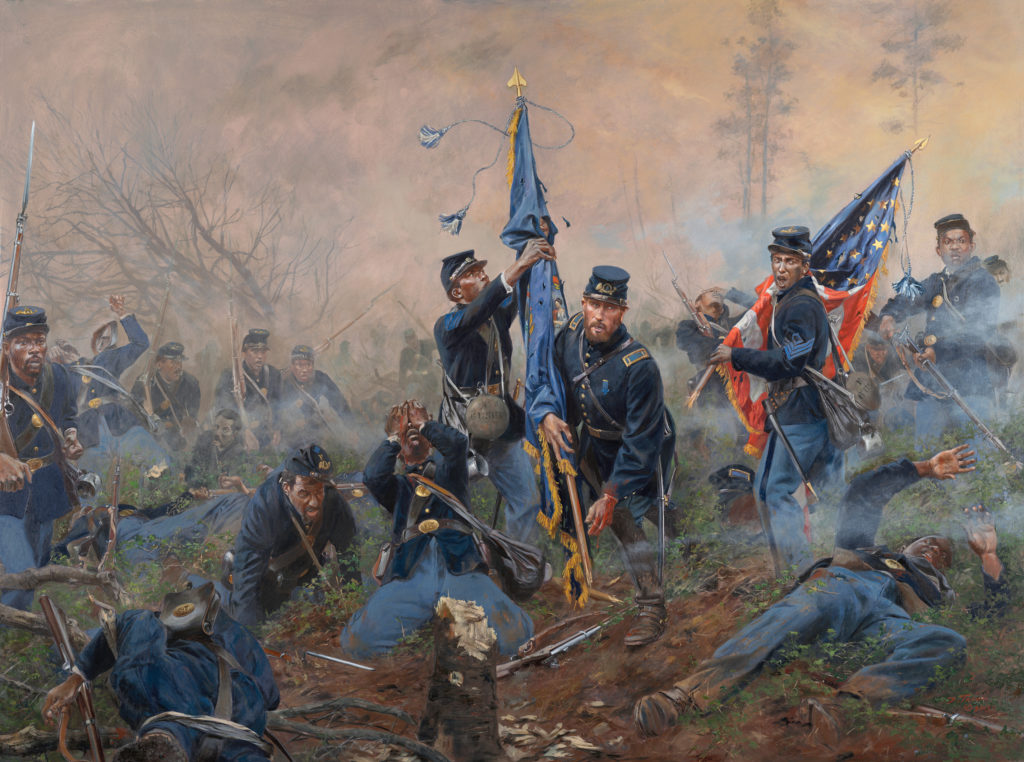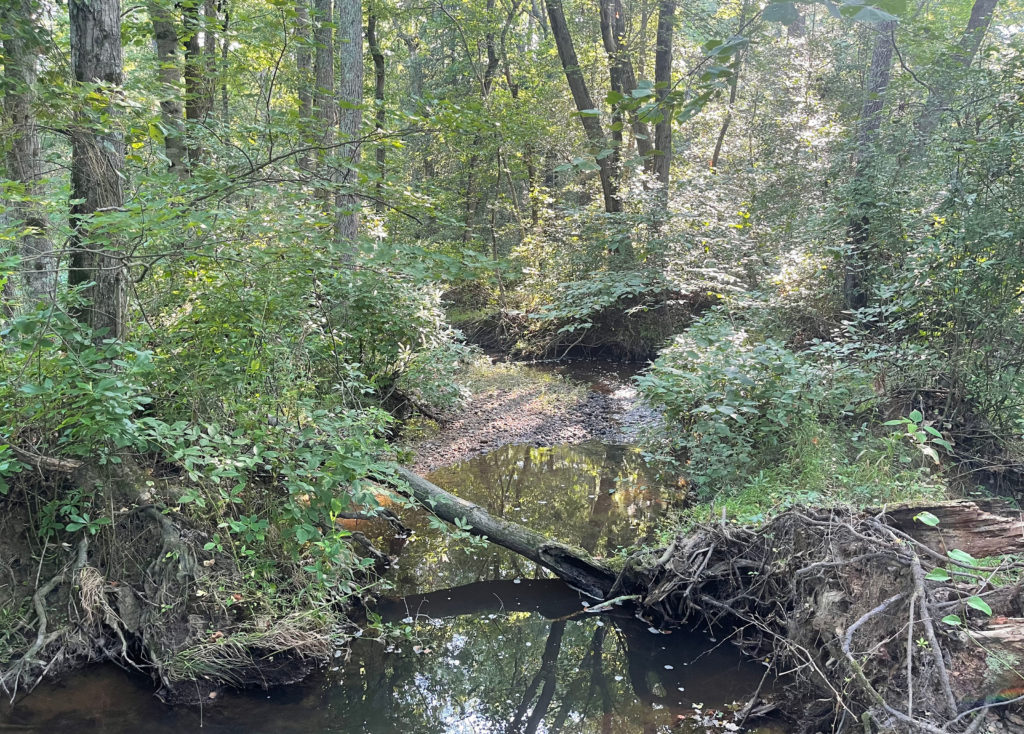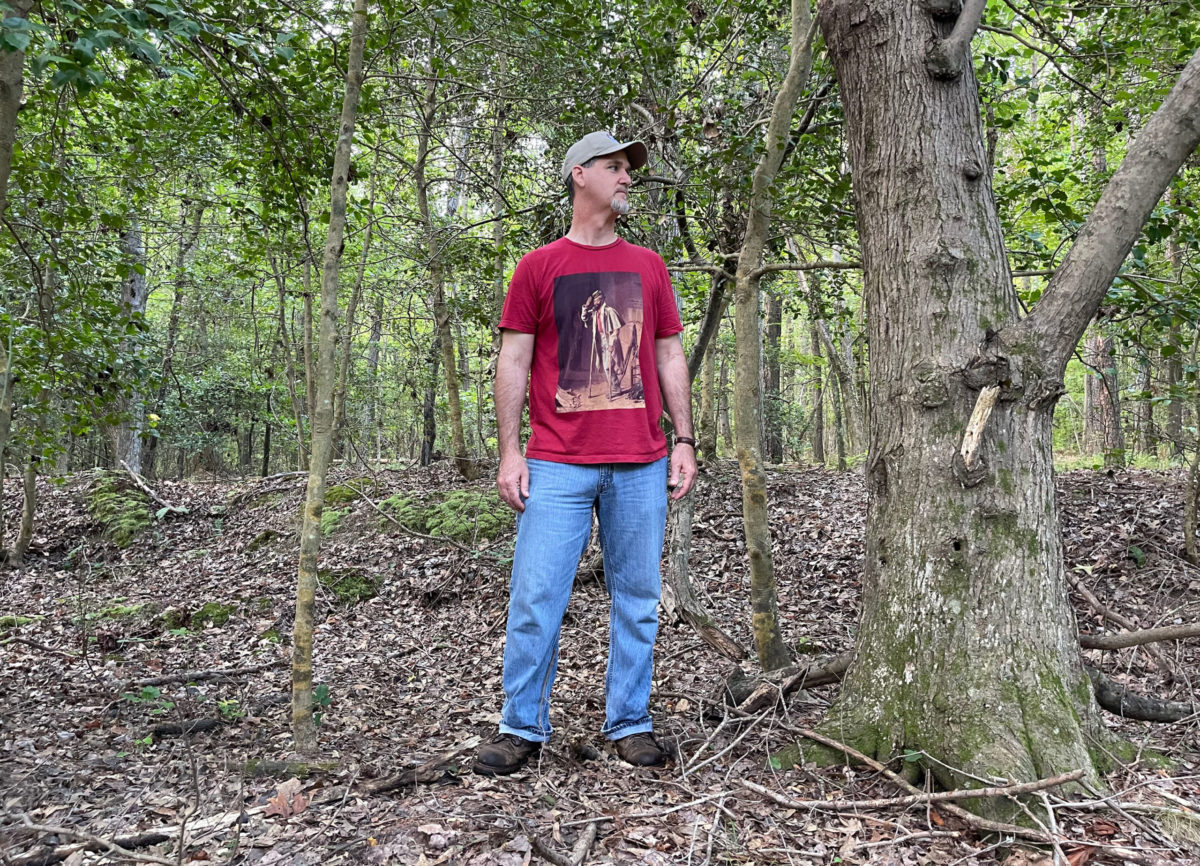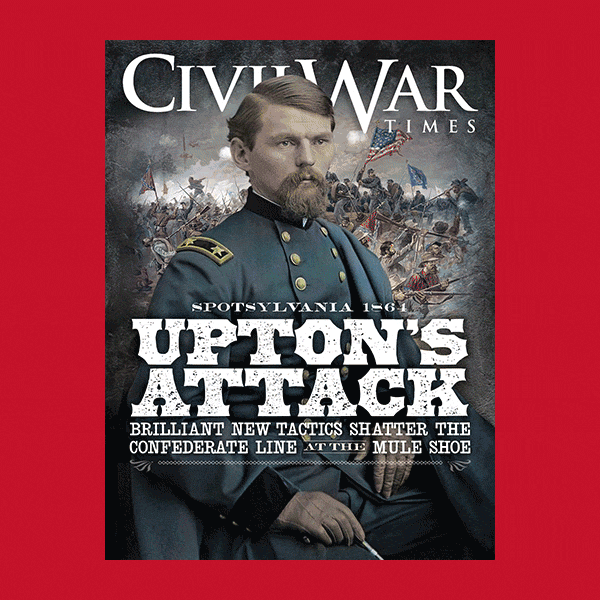After spending a sleepless Saturday night in a sketchy Richmond hotel, I drive surprisingly uncongested highways to the unheralded New Market Heights battlefield, where U.S. Colored Troops made history. Promptly at 8:30 a.m., I arrive at the already crowded Four Mile Creek Park parking lot, located behind a snake-rail fence astride New Market Road. All my deep-weeds battlefield walk essentials are accounted for: bug spray, long pants, hiking boots, water, snacks, a cellphone and backpack, and curiosity.
Days earlier, Tim Talbott—my New Market Heights guide—had messaged me a warning: “It’s supposed to be as hot as blue blazes.” His forecast proves spot-on. Virginia in late July is hell with the lid off. But I figure Talbott—the 52-year-old Central Virginia Battlefields Trust chief administrative officer—won’t mind.
“It’s always an honor to be on that ground,” he messaged me in a follow-up to his weather report.
In the parking lot in Henrico, 10 miles southeast of downtown Richmond, Talbott and I exchange pleasantries. This is our first meeting in person, although we’ve made dozens of Civil War–related connections online. Talbott wears blue jeans, an olive ballcap with the CVBT logo, and a maroon T-shirt. Strands of gray appear in the soft-spoken Tennessee native’s black goatee. He lives in Fredericksburg, Va., a 70-mile drive north on beastly Interstate 95.
Talbott has secured permission from Henrico County for us to walk the core New Market Heights battlefield, where, on September 29, 1864, 14 U.S. Colored Troops soldiers and two of their white officers earned the Medal of Honor. The county owns the most important swath of the battlefield, now blanketed by a forest of pine, holly, gum, and oak.
Our battlefield walk begins at a large garbage dumpster, behind a Dairy Queen on the opposite side of New Market Road. Three feral cats—two black, one gray—scatter as we walk toward them and disappear into the woods.
New Market Heights has been stiff-armed in the history books, but it is Talbott’s favorite battlefield. Armchair historians sometimes confuse it with the Battle of New Market, fought in the Shenandoah Valley in mid-May 1864. Talbott’s interest in the battle stems from a talk given by a professional historian nearly 20 years ago.
“The way he told the story made it come alive,” he says while brushing away pine branches along our narrow path through the woods.
My interest in New Market Heights stems from a meeting at nearby Fort Harrison weeks earlier with Damon Radcliffe, the great-great-grandson of Edward Ratcliff. A former slave, Edward served in the 38th U.S. Colored Troops and received one of those 14 Medals of Honor. Damon and I couldn’t walk the battlefield that day, but I vowed to return. My mantra: If you want to understand a battle, you must walk the ground.
Fifteen minutes into our walk, we reach a section of woods where the earth undulates, like a haphazardly tossed brown blanket. We have arrived at the remains of earthworks created by the famed Texas Brigade.
“Used to be chest high,” Talbott says of defenses, now only as high as three feet in places.
Piles of brown leaves, as well as gnarly tree roots, scattered broken twigs, tree branches and limbs, carpet the forest floor. Mayflies make pests of themselves while cicadas buzz and click. About a half-mile away, traffic hums on six lanes of Interstate 295, which slices through the battlefield like a bayonet through the heart.
In a charge about daybreak toward the earthworks, Black troops shouted: “Remember Fort Pillow! No quarter for the Rebels.” Nearly six months earlier, troops commanded by Nathan Bedford Forrest had massacred USCT at Fort Pillow in Tennessee.
On that bleak, foggy morning at New Market Heights, Black soldiers were out for revenge and a chance to prove their mettle. With one great push by the Union Army, USCT soldiers could soon be marching into the capital of the Confederacy.
Behind earthworks, the Texas Brigade, some 2,000-strong, fired thousands of rounds into the oncoming USCT soldiers they despised. Meanwhile, Rebel artillery, positioned at opposite ends of the heights behind the brigade, poured iron into the USCT.
Fifty to 75 yards in front of their earthworks, the Rebels had placed abatis—sharpened tree branches—and wooden chevaux de fries, the distant cousin of barbed wire. Gaps in the defenses funneled the Black soldiers into a kill zone.
“The Texans,” a Georgia officer wrote, “killed n——s galore.”
Confederate soldiers occasionally advanced beyond their earthworks to strip the dead of shoes, weapons, and ammunition. They murdered at least one captured USCT soldier behind their lines.
Talbott and I venture deeper into the woods, to get a USCT soldier’s perspective of the battlefield.

Perspiration pours down my arm, soaking my reporter’s notebook and blurring my scribbled words. I’ve never sweat so much on a battlefield—even in Resaca, Ga., during a reenactment on a blistering mid-May afternoon.
Soon, the drone of interstate traffic becomes a memory. The ground slopes gently up toward the Texas Brigade’s earthworks, which stretched for roughly ¾ of a mile. But the tree-covered landscape—largely open ground in 1864—makes New Market Heights mostly a battlefield of the mind.
To create a path through the woods, Talbott uses a long stick to swat away holly branches and spider webs. Neither of us wants to take home a blood-sucking tick as a memory of this experience.
“Is this remote enough for you?” Talbott asks.
Eighty yards or so beyond Rebel earthworks, we stop at the edge of a 50-acre rock quarry filled with water—a nasty 20th-century scar on hallowed ground.
“A friend of mine jokes that you could only give kayak tours here now,” Talbott says.
In Talbott’s perfect world, the quarry would be emptied and filled in. The battlefield where hundreds of Black soldiers and their White officers shed blood would be restored to its 1864 appearance and interpreted. Soldiers such as Corporal Miles James of the 36th USCT, among the 14 Medal of Honor recipients from this battle, would be at least as well-known as Benjamin Butler—the Army of the James general who commanded them.
Born in Princess Anne County, Va., James had enlisted in Norfolk in November 1863. A 34-year-old farmer, he probably was enslaved before the war. He stood 5 feet 7 with black eyes and hair.
Within 30 yards of Texas Brigade defenses, a bullet burrowed into James’ upper left arm, shattering bone. Somehow the corporal continued to load and fire his weapon with his good arm, urging on comrades as the battle swirled. James endured the amputation of his useless limb on the battlefield. Later, the corporal received treatment at Fort Monroe, 75 miles east in the Virginia coast, and a promotion to sergeant.
Despite losing an arm—a golden ticket out of the service if he wanted it—James refused to leave the army. In February 1865, Colonel Alonzo Draper—who commanded James’ brigade at New Market Heights—wrote Fort Monroe’s chief surgeon:
“He is one of the bravest men I ever saw; and is in every respect a model soldier. He is worth more with his single arm, than half a dozen ordinary men.”
James served in the U.S. Army until a disability discharge in October 1865. Hundreds of other Black soldiers like him, nearly all of them former slaves, fought as well as James at New Market Heights.
“Unbelievable bravery,” Talbott says of the USCT.
At Four Mile Creek, which snakes its way through the battlefield before dumping into the James River, Talbott and I talk about the white officers on horseback who became prime targets of the Rebels.
“This is where the Rebels thought the USCT would become nothing but rabble after the officers fell,” Talbott says. The creek itself became a devilish impediment to USCT soldiers under withering fire.

At creekside, I learn more about Talbott, too.
He grew up in Madison, Ind., a stop on the Underground Railroad—the network escaped slaves used to flee to free states and Canada. At his 1,000-student high school, he played football (“not very well”) and grew to enjoy rap and hip-hop—which some of his white peers thought strange.
Talbott’s high school history teacher—“a 1960s hippie”—exposed him to “all the cultural stuff,” including the Civil Rights era and two of its leading personalities, Malcolm X and Martin Luther King. For the past 30 years, he has immersed himself in the experiences of Black people during the Civil War.
On his phone, Talbott displays wallpaper of Frederick Douglass—the famous Black orator, abolitionist, writer, and reformer. The copy of the painting on his maroon T-shirt, now drenched with sweat, is of a one-legged USCT soldier on crutches. Talbott dreams of a monument at Four Mile Creek Park to honor the USCT, who forced the Texas Brigade to fall back to a secondary line. The Black troops ultimately entered Richmond, but not until after the capital’s fall in April 1865.
As we walk through the Virginia forest, Talbott and I wonder why this battle—and this battlefield—have been consigned to the shadows of history. Racism? Indifference? Ignorance? In the late 1980s and early 1990s, an effort failed by a Black military history group to have the battlefield named a National Historic Landmark.
Thankfully, hundreds of acres of the New Market Heights battlefield have been saved by the American Battlefield Trust and other preservation groups. But much has been lost forever because of modern development.
Two hours after our walk began, sweaty and dirty, we leave the woods and September 1864 behind. On a pathway along New Market Road to the Four Mile Creek Park parking lot, Talbott and I talk about the battle, preservation, and Civil War memory.
“Many people say they love history, but what they really love is nostalgia,” he says. “I love messy history. That’s where the good stuff is.”
Messy history—that’s a perfect encapsulation of the Battle of New Market Heights.
John Banks, author of two Civil War books, has another one coming in 2023. Check out A Civil War Road Trip of a Lifetime (Gettysburg Publishing) for more on this story. For more on New Market Heights, including soldier stories, go to battleofnewmarketheights.org






